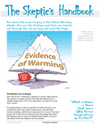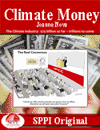|
|
Steve Milloy at JunkScience holds the media and EPA scientists up to the same standards they expect from skeptics like Willie Soon.
The Headlines are everywhere:
” E.P.A. Carbon Emissions Plan Could Save Thousands of Lives, Study Finds “— NY Times
And the media go out of their way to make sure everyone knows what independent angels they are:
Peer-reviewed, non-partisan academic study finds that the EPA emissions rule will save thousands of lives (Lindsay Abrams) — Salon
In most articles the study authors were just researchers from Harvard and Syracuse Uni, who declare “they have no competing financial interests”.
Milloy wonders if $31 million in EPA grants could be a competing interest? Five of eight authors are paid grants by the EPA.
Below are listed the article’s authors and the dollar amounts of EPA grants with which they are associated as principal investigators”:
Charles T. Driscoll: $3,654,608 Jonathan J. Buonocore: $9,588 Jonathan I. Levy: $9,514,391 Kathleen F. Lambert: 0 Dallas Burtraw: $1,991,346 Stephen B. Reid: 0 Habibollah Fakhaei: 0 Joel Schwartz: $31,176,575
Now how could Schwartz’s $31,176,575 or Levy’s $9,514,361 or Driscoll’s $3,654,608 from EPA […]
The wall of money is enormous, and the media oblivious to the real flow from taxpayers to corporate welfare freeloaders.
The wall of money, part 23
Citigroup promised to spend, invest and loan $50 billion in 2007 and found it so easy, it managed to do it by 2013, three years ahead of schedule. This month it promised to send another $100 billion more towards “sustainability”.
How much of this is about being a green corporate citizen? Not much apparently. Citigroup are making the Citigroup buildings energy efficient, but what they didn’t say was whether they would stop investing in or taking money and profits from their fossil fuel customers. As it happens Citigroup might Big-Green, but they are also Big-Ungreen too, they were one of “the top providers of funding for the most damaging practices of the U.S. coal industry last year. “ Not that any journalist mentioned that when they repeated the press release.
The banks can sniff out a good subsidy — it’s money for jam, and they are happy to feed the machine that feeds them.
Easy money for “sustainability” will also generate thousands of scary press releases from each and every sub-project as they […]
This is about much more than just Willie Soon. The fans of man-global warming know they can’t win a polite science debate. They know the biggest threat to the green gravy train is for competitive research, free debate, and independent funding for scientific research. The anti-science brigade want to stamp out and starve independent research. Where once companies would be lauded for their philanthropy, now they are forced to hide it knowing they’ll be targeted, and no matter how good the research work and publications are the results won’t even be discussed if smear-fans can talk about “funding” instead.
Welcome to the dark world of manufactured petty smear campaigns against scientists.
Where was the outrage when a lead author of an IPCC report was paid by Greenpeace? Do the puritans of science funding care when GE lobbies for renewables subsidies, or owns parts of media outlets? GE makes $21 billion a year on “Clean Energy”.
What we need is a science debate, but if “science writers” want to talk money, I say Yes Please. Lets talk about the wall of money distorting science from monopolistic government funding. This one vested interest is running at almost 100% purity in climate science. […]
David Rose at the Daily Mail has been following a network of money. The big machine funding climate activism is Climate Works, which was kicked off with a half billion from a Hewlett Foundation in 2008 (as in Hewlett-Packard). Other donations are in the order of $60 – $100 million, any one of them vastly larger by orders of magnitude than budgets that skeptical groups operate on (if they have a budget at all).
It takes a lot of money to keep a false idea alive. This is just another Wall of Money. Yet despite that, skeptics are winning battles, unwinding schemes, shrinking the Green gravy trains, and spreading the word. It’s amazing what a small group of volunteers and barely funded skeptics can achieve with only their wits and truth on their side. (Thank you to the readers who help us, it makes a big difference.)
ClimateWorks feeds money to the whole gamut of groups like Greenpeace, WWF, and the usual suspects, and it partners with the European Climate Foundation, and in the US, the Energy Foundation. There are Chinese and Indian branches and an Australian Climate Works as well (but it’s not clear how or if the latter […]
Some extraordinary statements from Owen Paterson, the man who was the UK Environment Secretary until a week ago. This is baking hot. Paterson also draws attention to the way big-goverment has fed big-government lobbyists 150 million euros since 2007. Can we get this man to Australia? — Jo
I’m proud of standing up to the green lobby
The Telegraph UK I leave the post with great misgivings about the power and irresponsibility of – to coin a phrase – the Green Blob.
By this I mean the mutually supportive network of environmental pressure groups, renewable energy companies and some public officials who keep each other well supplied with lavish funds, scare stories and green tape. This tangled triangle of unelected busybodies claims to have the interests of the planet and the countryside at heart, but it is increasingly clear that it is focusing on the wrong issues and doing real harm while profiting handsomely.
Local conservationists on the ground do wonderful work to protect and improve wild landscapes, as do farmers, rural businesses and ordinary people. They are a world away from the highly paid globe-trotters of the Green Blob who besieged me with […]
Finally, some coverage of the massive amount of money pumping the Big-Green agenda. What is really so remarkable about this is that skeptics are winning, despite the fact that the greens have almost all the institutional, academic, government, and big-media support, and far, far more money. All we have is truth and wits.
The Washington Examiner
Mainstream media don’t know Big Green has deeper pockets than Big Oil
Ron Arnold
Mainstream reporters appear not to be aware of the component parts that comprise Big Green: environmentalist membership groups, nonprofit law firms, nonprofit real estate trusts (The Nature Conservancy alone holds $6 billion in assets), wealthy foundations giving prescriptive grants, and agenda-making cartels such as the 200-plus member Environmental Grantmakers Association. They each play a major socio-political role.
Seeing Big-Green funding means taking a broader view of the money trail:
Invisible fact: the environmental movement is a mature, highly developed network with top leadership stewarding a vast institutional memory, a fiercely loyal cadre of competent social and political operatives, and millions of high-demographic members ready to be mobilized as needed.
That membership base is a built-in free public relations machine responsive […]
Look out, Australia might trim a tiny slice from the Tithe to the Gods of Weather (protest coming)
The Australian budget is in dire straits after the Rudd-Gillard years of promised surpluses but exploding arithmetic. The Commission of Audit is here to test public reaction to all the possible ways of paying off the Labor debt. Somehow, it missed the biggest cherry waiting to be plucked. We could save billions if the the Abbott Government become more rigorously scientific. Abbott should cut funding to any scientists who are using models that don’t work, and only fund ones that do.
“Abbott should cut funding to any scientists who are using models that don’t work, and only fund ones that do.”
I expect the Greens will join me in declaring that if the Abbott government cared about the environment it would immediately launch a royal commission, a real audit, or an independent investigation into the effect of carbon dioxide. Only the best science for the planet, right? All funding to environmental programs dependent on unverified research should be frozen until the audit is finished. Easy eh? Let me be PM for a day. :- )
But apparently the sacred carbon cow must […]
I say, it’s lucky people who want to save the planet do it for the love of it:
National Post: The Kyoto Protocol’s Clean Development Mechanism (CDM) has helped funnel almost $400-billion into emission-cutting projects in developing countries by allowing investors to earn carbon credits they can sell to companies and governments of richer nations that use them to meet emission targets.
I imagine they love $400 billion too.
This was just one branch of the great green-industrial-machine. (And yet skeptics are winning, she says wickedly, with hardly any money).
But those halcyon days are gone for the CDM — what was $30 per ton, is now 30c.
From 2003, developers flocked to register projects such as destroying heat-trapping waste gasses at Chinese chemical plants or installing hydroelectric power stations in Brazil, and made huge profits by selling the resulting carbon credits for up to $30.40 a tonne in 2008.
But interest has waned while countries wrangled over setting new emission goals under the United Nation’s Framework Convention on Climate Change (UNFCCC), hammering credit prices down to unprofitable levels below $0.30.
There’s a tiny $200 million or so left ticking over in the accounts:
The latest UN financial statements show […]
Another cycle of the Climate Change Scare Machine is laid bare. David Rose explains how those lobbying and advising the government on green policies are benefiting from green projects. It’s all in the Daily Mail. The Green Industrial Complex has simply bought everyone off, and, cleverly, done it with your money.
It’s the new business model really. Why work for customers and compete in the free market? Instead scare the public, sell them the “answer”, and to make sure they pay, convince the government that you need grants and gravy (or you’ll call them names). Pretty soon, the government forces the public to pay, disguises and splits the payments into a thousand parts, and tells the people it is for their own good. The fun ramps up when the government hires you back to advise it on how to keep the gravy flowing to you.
What is really mindboggling is that it’s so blatant. Many of these connections “exposed” by Rose are listed on the CCC website, the conflicts are obvious. Why it wasn’t exposed years ago? As I keep saying, the problem is not so much that there are people on the take (there always will be) the real […]
More good news.
The CDM is one of the only truly global carbon markets. It’s been the main mechanism for “mitigation” in developing countries, (China says “thank you”). Born with the Kyoto agreement, it was in a sick state last year and was even said to have collapsed. Now however it’s reached a state of “coma”.
Each CDM was worth 20 euros in 2008. Now they are selling for 50c.
Reuters: Investment under the U.N.’s $315 billion Clean Development Mechanism (CDM) has ground to a halt as the value of the credits they generate has plunged 95 percent in five years to around 0.30 euros, crushing profits that investors count on to set up carbon-cutting schemes in the developing world.
“As a tradable commodity, it’s in a coma and will be unless and until a 2015 agreement wakes it up,” said Jorund Buen, co-founder and partner at consultancy and project developer Differ.
A lot of things could be said about the last UNFCCC meeting in Warsaw. Here’s the one that matters:
“…no major nation offered to set or deepen emission targets, while Japan scaled down its 2020 goal.”
The language of death:
“…almost 200 nations “expressed concern” over the state […]
It’s just another day tracking the decline of the global warming meme.
Things were so pear-shaped for global carbon trading markets in 2012 that the World Bank canceled its annual State of the Carbon Market report. But how bad were they? In their last report in 2012 the grand global total was $176b USD for the 2011 year. Since the World Bank figure are not publishing their tally any more, I’ve switched to the Reuters Point Carbon figures instead, which are issued in Euro.
Rather devastatingly, despite the fact the FTSE grew 6% in 2012 and Euro Stoxx grew by 13% in 2012, the global carbon market (which is mostly an EU market) fell by a whopping 36% in 2012. Money printing is running rife and new money is pouring into asset markets worldwide, yet globally the money is running from invisible, rortable, pointless carbon certificates. We are past the peak, and over the hill. This parrot is almost dead.
Back in the heady days of 2008 the growth was described as “explosive” and it was predicted it would grow to $1.2 trillion by 2020 (about 880 billion €) .
…
These figures are different to previous USD ones, […]
More money leaves the room. Last week David Cameron said the UK needed to get rid of all that green crap (or double-speak words to that effect). The message, confounded as it is, may be getting through.
(Reuters) – German utility RWE has scrapped plans to build one of the world’s largest offshore wind parks in Britain, as soaring gas and electricity prices fuel uncertainty over the UK government’s commitment to renewable energy subsidies.
[Bloomberg] RWE’s renewable-energy unit has decided to drop a 4.5 billion-pound ($7.3 billion) offshore wind project in the U.K. because engineering challenges made it too expensive.
RWE says that it’s because of engineering challenges, but we could assume they didn’t suddenly discover how deep the water was this week.
[Bloomberg] “At the current time, it is not viable for RWE to continue” the Atlantic Array farm because of deep waters and adverse seabed conditions, RWE Innogy said in a statement on its website. The 278-turbine project in the Bristol Channel can’t be justified under “current market conditions,” it said.
Engineering challenges can usually be fixed with money. But translate “current market conditions” and we see that it was really a money […]
And people wonder why Greece, Italy and Spain are in a mess.
By Sophie Yeo in Warsaw
20% of the EU’s budget will go towards fighting climate change, climate commissioner Connie Hedegaard announced in Warsaw today.
This equates to €180 billion on climate spending between 2014 and 2020, which will be used to reduce emissions domestically and help developing countries adapt to climate change—three times what was provided in the previous budget.
Much of this will be spent on domestic projects, helping with the development of climate-smart agriculture, energy efficiency and the transport sector.
But of course, much of this is just a PR statement (otherwise 20% of the rest of the EU budget has been cut. Where are those screams?). The money is probably relabeled: shifted from one category to another. Same spending, greener tint.
They even admit themselves, they are taking €15 billion away from overseas aid in order to soothe their anxiety about the weather 100 years from now. This will mean a lot to hungry people in Cambodia.
If I thought that €15 billion would have been efficiently used, this would be a real disaster:
Over the next seven years, €15 billion from the EU’s […]
At least someone once thought London was the home of carbon finance. Now, not so much. According to the Financial Times, JP Morgan has scaled down their carbon trading team, Morgan Stanley traders are now “part time”, Barclays sold theirs last year, Deutsche Bank closed the office, and UBS shut its climate change advisory panel. Then there is a slew of smaller fish cutting back: EcoSecurities, Camco Clean Energy, Nedbank, Sindacatum, and TFS Green.
[Financial Times] At least 10 London banks have scaled back or closed their carbon trading desks amid turmoil in the European emissions trading scheme.
The fledgling market was once seen as a promising growth area, with the City of London Corporation predicting in 2006 that London would become the leading provider of services to the “mushrooming” sector.
But the number of City workers employed on carbon desks has fallen by 70 per cent in the past four years, according to Anthony Hobley, president of the Climate Markets & Investors Association.
Things are dire:
“…as a stand alone business it is basically over,” said an executive who oversees European energy trading at one large bank.
Read the full story here (Paywalled for some?)
The State of the […]
Here’s a stark statistic that came out last week in a new report: The Climate Industry draws in nearly $1 billion dollars a day. But here’s an ominous combination: … it openly admits that taxpayer money is its “engine-room”. Reading between the lines below, this industry is almost completely dependent on domestic policies that funnel money from citizens to itself, and tilts the playing field — without those policies, it can’t attract much private money. That is, it can only get money at least partially by coercion, people won’t give it money purely voluntarily. These same groups want even more — they want the public to take the risks too. What could possibly go wrong?
Al Gore, said it himself: “Special interests control decisions too frequently.” [See the ABC]. So he must be concerned about the lobbying weight of a $360 billion dollar baby whose existence is contingent on government gravy? As if…
From: The Global Landscape of Climate Finance 2013 from the Climate Policy Initiative
“Landscape 2013 finds that global climate finance flows have plateaued at USD 359 billion, or around USD 1 billion per day – far below even the most conservative estimates of investment […]
[See our concise and updating story of the bet here.]
Commenters often ask us if I am prepared to make a bet and put “your money where your mouth is.” The answer is: been there — done that. We (as in David Evans and I) already have and a long time ago. As far as I know, it’s one of the largest private bets going on the climate*. David bet against Brian Schmidt, $6,000 to $9,000, in early 2007 on outcomes over 10, 15 and 20 years.
The bet was made a year before I started blogging. It was literally the first action we took as skeptics (instigated and hammered out almost entirely by David, with my support). So we have $6,000 exposure — betting that global temperatures would not rise faster than 0.15C per decade, as judged by GISTemp. How are we doing on this bet? Judging by the trend at the moment, pretty well. Brian is still optimistic that he will win on the later outcomes. (This is part of the reason we are particularly interested in trends from 2005, which is when the bet temperatures begin to count.) Kudos to Brian both for being one […]
Let the historic dissection begin. Man-made global warming is a dying market and a zombie science.
The Carbon Capture Report, based in Illinois, tallies up the media stories from the English speaking media on “climate change” daily. Thanks to the tip from Peter Lang, we can see the terminal trend below. The big peak in late 2009 was the double-whammy of Climategate and Copenhagen (aka Hopenhagen). It’s all been downhill since then.
Mentions of “climate change” in news, blogs and tweets dropped suddenly from July 29, 2011
Source: Carbon Capture Report
But something that caught my eye was the drop in mid 2011 (or precisely — July 29, 2011) when media stories fell by half, a step-change fall from which they never recovered.
Media Matters, and Joe Romm make much of of the fact that after Paul Ingrassia (a skeptic) was appointed as Reuters deputy-editor-in-chief news coverage of climate change fell by half.
Media Matters found a 48% decline in climate-change coverage over a six-month period, after Ingrassia joined the agency in 2011.
But Ingrassia started in April 2011 not July. Media Matters compares 6 months before the global fall Oct 2010 – April 2011 — to […]
State of the Carbon Market: Started in 2003, but wiped out in 2013
Each year for nearly a decade The World Bank has published “The State and Trends of the Carbon Market” in May or June with great fan-fare and press releases. It’s the definitive guide telling the world how many dollars are turning over in the global markets (which really means “the EU market plus a few other bits”). I’ve been quoting their figures for years — The 2012 report told us that $176 billion dollars turned over in 2011. So what was the number for the 2012 year? Whatever it is, it’s so bad the World Bank cancelled the report.
Figure what the cancellation of the report tells us about the The World Bank. Was it publishing these figures for the last nine years because they were important for investors and policy-makers? I guess not, or they would still be publishing them. By dropping it at the first major downturn, we know the reason for the report was pure PR, something for whipping up momentum about the market and getting headlines in newspapers. The numbers in 2013 became a PR disadvantage — the World Bank did […]
So what does this mean? Billions more dollars poured into the uber carbon gravy train? Twenty whole percent?
Current climate spending is estimated at 5-7%. So this might be a big increase. Has the EU gone over the waterfall, or is it more a PR exercise where money that would have been spent on other things is rebadged as a “climate” expenditure.*
The power of a single department may get diffused and spread among lots of departments. WWF are not happy and nor is the European Environmental Bureau. It can’t be all bad. ( 🙂 )
Environment News Service
BRUSSELS, Belgium, February 8, 2013 (ENS) – European heads of state and government have agreed to commit at least 20 percent of the entire European Union budget over the next seven years to climate-related spending.
All-night negotiations in Brussels produced agreement among EU leaders on budget proposals for the rest of the decade, from 2014-2020.
“Climate action objectives will represent at least 20% of EU spending in the period 2014-2020 and therefore be reflected in the appropriate instruments to ensure that they contribute to strengthen energy security, building a low-carbon, resource efficient and climate resilient economy that will enhance Europe’s […]
While cancer patients will have to pay more or wait longer for treatment, the Department To Fix The Weather handed out nearly 1 billion dollars in 2010-2011, some* of which was used to “educate” people about energy efficiency and the benefits of government policies.
*UPDATE: While there are a lot of “education” grants in 2012, there are some research grants going to the CSIRO (eg in 2012 at least $13m of the $40m that year was for research at CSIRO). In 2010 (the big dollar grant year) many more of the grants were for “strategies”, for IPCC matters, for universities and the CSIRO — though none of the grants I’ve seen on a random sample add up to anything like the total outgoing.)
Is this advertising by any other name? Instead of running an ALP campaign advert, they award money to groups which promote their policies and get disguised third party ads by NGOs who collect donations and are seemingly the voice of the community (what percentage of these non-profits comes voluntarily from the community and what percentage comes via forced payment from tax?).
“Do Something” picked up $800,000 to become a type of GONGO and run a […]
|
JoNova A science presenter, writer, speaker & former TV host; author of The Skeptic's Handbook (over 200,000 copies distributed & available in 15 languages).

Jo appreciates your support to help her keep doing what she does. This blog is funded by donations. Thanks!


 Follow Jo's Tweets
Follow Jo's Tweets To report "lost" comments or defamatory and offensive remarks, email the moderators at: support.jonova AT proton.me
Statistics
The nerds have the numbers on precious metals investments on the ASX
|












Recent Comments